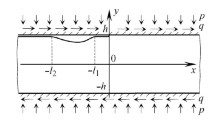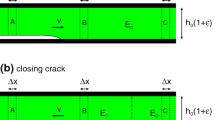Abstract
A general two-dimensional solution has been obtained analytically for the crack with interating rough faces. The interaction has been modelled at a large scale as (1) Mohr-Coulomb friction and (2) the crack opening being a known function of sliding. The detailed consideration of a crack with saw-like faces has shown that the energy release rate is less than for a conventional shear crack. Tensile stress concentration caused by the crack opening reduces the angle of kinking though not sufficiently to make the crack propagate in its own plane. At a certain magnitude of shear loading the opening reaches its maximum value determined by the height of asperities. Starting from this point the zone where the maximum opening is reached rapidly increases and the dependencies of crack face displacements and the area of crack opening on the load become nonlinear. This however does not affect values of the stress intensity factors.
Key words: Dilation, friction, opening, saw-like faces, shear crack, stress intensity factors.
Similar content being viewed by others
References
Ballarini, R.A. and Plesha, M.E. (1987). The effects of crack surface friction and roughness on crack tip stress fields. International Journal of Fracture 34, 195–207.
Ballarini, R., Parulekar, A. and Plesha, M.E. (1990). Finite element modelling of discontinuities with dilatancy and surface degradation. Engineering Fracture Mechanics 35, 385–397.
Barton, N.R. (1986). Deformation phenomena in jointed rock. Geotechnique 36, 147–168.
Barton, N.R., Bandis, S. and Bakhtar, K. (1985). Strength, deformation and conductivity coupling of rock joints. International Journal of Rock Mechanics and Mining Science 22, 121–140.
Bazant, Z.P. and Gambarova, P. (1980). Rough cracks in reinforced concrete. Journal of the Structural Division, Proceedings of the American Society of Civil Engineers 106, 819–842.
Bobet, A. and Einstein, H.H. (1996). Fracture coalescence in rock material under uniaxial and biaxial loading. Rock Mechanics (Edited by Aubertin, Hasani and Mitri), 1603–1609.
Carlson, R.L. and Beevers, C.J. (1985). A mixed mode fatique crack closure model. Engineering Fracture Mechanics 22, 651–660.
Cherepanov, G.P. (1979). Mechanics of Brittle Fracture, McGraw-Hill, New York.
Cherepanov, G.P. (1987). Fracture Mechanics of Rocks in Drilling, Moscow, Nedra (in Russian).
Dyskin, A.V. (1997). Crack growth criteria incorporating non-singular stresses: Size effect in apparent fracture toughness. International Journal of Fracture 83, 191–206.
Elber, W. (1970). Fatigue crack closure under cyclic tension. Engineering Fracture Mechanics 52, 37–45.
Evans, A.G. and Hutchinson, J.W. (1989). Effects of non-planarity on the mixed mode fracture resistance of bimaterial interfaces. Acta Metallurgica 37, 909–916.
Gakhov, F.D. (1990). Boundary value problems, Dover Publications,Inc., New York.
Gol'dstein, R.V. and Entov, V.M. (1977). Variational bound and qualitative methods in fracture mechanics. Fracture, ICF 4, Waterloo, Canada, 93–121.
Goodman, R.E. (1989). Introduction to Rock Mechanics, John Wiley & Sons.
Gross, T.S. and Mendelsohn, D.A. (1988). On the effect of crack face contact and friction due to fracture surface roughness in edge-cracks subjected to external shear. Engineering Fracture Mechanics 31, 405–420.
Gross, T.S. and Mendelsohn, D.A. (1989). Model I stress intensity factors induced by fracture surface roughness under pure mode III loading: Application to the effect of loading modes on stress corrosion crack growth. Metallurgical Transactions 20A, 1989–1999.
Lockner, D.A., Byerlee, J.D., Kuksenko, V., Ponomarev, A. and Sidorin, A. (1992). Observations of quasistatic fault growth from acoustic emission. Fault Mechanisms and Properties of Rocks (Edited by Evans and Wong), 3–31.
Mendelsohn, D.A., Gross, T.S. and Zhang, Y. (1995). Fracture surface interference in shear-I. A model based on experimental surface characterizations. Acta Metallurgica et Materialia 43, 893–900.
Muskhelishvili, N.I. (1953). Some Basic Problems of the Mathematical Theory of Elasticity, P. Noordhoff Ltd, Groningen, the Netherlands.
Patton, F.D. (1966). Multiple modes of shear failure in rock. Proceedings of the First Congress of ISRM, Lisbone 1, 509–513.
Rice, J.R. (1968).Mathematical analysis in the mechanics of fracture. Fracture. An advance treatise. Mathematical Fundamentals (Edited by H. Liebowitz), Vol. 2, Academic Press, New York and London, 191–311.
Savruk, M.P. (1981). Two-Dimensional Problems of Elasticity for Bodies with Cracks, Kiev, Naukova Dumka (in Russian).
Tschegg, E.K. (1983). Mode III and Mode I fatigue crack propagation behaviour under torsional loading. Journal of Material Science 18, 1604–1614.
Tong. J., Yates, J.R. and Brown, M.W. (1995). A model for sliding mode crack closure. Part I: Theory for pure mode II loading. Engineering Fracture Mechanics 52, 599–611.
Author information
Authors and Affiliations
Rights and permissions
About this article
Cite this article
Dyskin, A., Galybin, A. Solutions for dilating shear cracks in elastic plane. International Journal of Fracture 109, 325–344 (2001). https://doi.org/10.1023/A:1011054309496
Issue Date:
DOI: https://doi.org/10.1023/A:1011054309496




